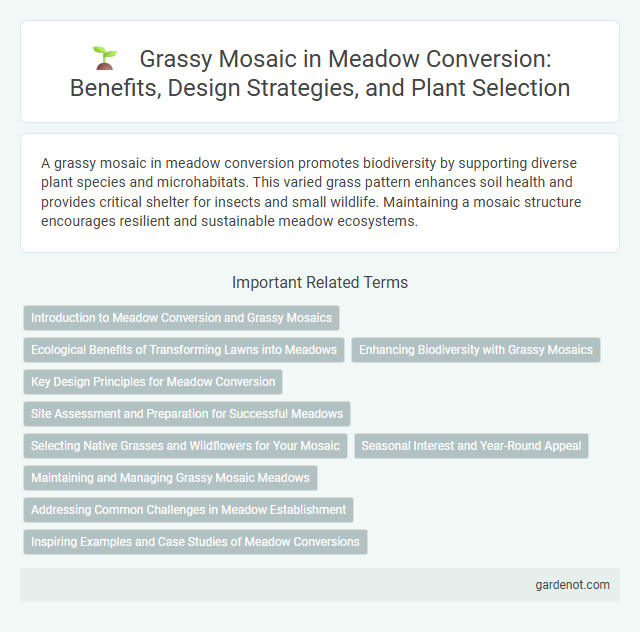A grassy mosaic in meadow conversion promotes biodiversity by supporting diverse plant species and microhabitats. This varied grass pattern enhances soil health and provides critical shelter for insects and small wildlife. Maintaining a mosaic structure encourages resilient and sustainable meadow ecosystems.
Introduction to Meadow Conversion and Grassy Mosaics
Meadow conversion transforms arable or barren land into diverse grassland habitats, promoting ecological balance and biodiversity. Grassy mosaics, characterized by interspersed patches of varying grass species and structures, enhance habitat complexity, supporting a wider range of flora and fauna. Implementing grassy mosaics within meadow conversion projects increases resilience against environmental stressors and boosts pollinator populations.
Ecological Benefits of Transforming Lawns into Meadows
Transforming traditional lawns into grassy mosaics significantly enhances biodiversity by providing diverse habitats for pollinators, insects, and small wildlife. These meadow ecosystems improve soil health through deep-rooted native plants, increasing carbon sequestration and water retention. The varied plant species reduce the need for chemical fertilizers and pesticides, promoting sustainable urban and suburban landscapes.
Enhancing Biodiversity with Grassy Mosaics
Grassy mosaics create diverse habitats by combining patches of native grasses and wildflowers, which support a wide range of pollinators, birds, and beneficial insects. This habitat complexity enhances ecological resilience and promotes species richness within meadow conversions. Incorporating grassy mosaics fosters sustainable biodiversity and improves ecosystem services such as soil health and pollination.
Key Design Principles for Meadow Conversion
Grassy mosaic design for meadow conversion emphasizes diverse plant species with varying heights and bloom times to enhance biodiversity and ecosystem resilience. Integrating native grasses alongside wildflowers creates layered vegetation structures that support pollinators and wildlife habitats. Soil preparation and minimal disturbance encourage natural seedling establishment, ensuring sustainable meadow development.
Site Assessment and Preparation for Successful Meadows
Effective site assessment for grassy mosaic meadow conversion involves analyzing soil composition, moisture levels, and existing vegetation to ensure optimal growth conditions. Preparing the site includes removing invasive species, ensuring proper drainage, and incorporating native seed mixes tailored to local ecosystems. Monitoring soil pH and nutrient levels supports successful establishment and long-term sustainability of diverse meadow habitats.
Selecting Native Grasses and Wildflowers for Your Mosaic
Selecting native grasses and wildflowers for a grassy mosaic supports local biodiversity and enhances ecosystem resilience. Choose species adapted to your region's soil type and climate, such as Big Bluestem (Andropogon gerardii) or Purple Coneflower (Echinacea purpurea), to ensure establishment and low maintenance. Incorporating a diverse mix of native plants provides year-round habitat for pollinators, birds, and beneficial insects while creating a vibrant, sustainable meadow.
Seasonal Interest and Year-Round Appeal
Grassy mosaic in meadow conversion creates dynamic seasonal interest by showcasing diverse textures and colors that evolve throughout the year. Native grasses and wildflowers bloom sequentially, offering vibrant spring blossoms, lush summer greenery, and warm autumnal hues. This cyclical growth pattern ensures year-round appeal, supporting local biodiversity and enhancing landscape aesthetics.
Maintaining and Managing Grassy Mosaic Meadows
Maintaining and managing grassy mosaic meadows requires targeted mowing regimes that preserve species diversity while preventing scrub encroachment. Optimal management includes rotational cutting patterns and seasonal grazing to support native flora and fauna, ensuring varied sward heights and microhabitats. Regular monitoring of plant composition and soil health is essential to maintain the ecological balance and promote sustainable meadow resilience.
Addressing Common Challenges in Meadow Establishment
Grassy mosaic in meadow conversion often results from uneven seed distribution and soil variability, limiting plant species diversity and establishment success. Implementing tailored soil preparation techniques and selecting a diverse seed mix adapted to local conditions enhances uniform growth and reduces patchiness. Monitoring moisture levels and controlling invasive grass species further supports balanced meadow development and long-term resilience.
Inspiring Examples and Case Studies of Meadow Conversions
Grassy mosaic patterns in meadow conversions illustrate diversified plant species that enhance biodiversity and ecosystem resilience. Case studies such as the Knepp Estate in the UK demonstrate how integrating native grasses with wildflowers creates vibrant habitats supporting pollinators and wildlife. These examples showcase measurable benefits in soil health, carbon sequestration, and aesthetic value, inspiring sustainable land management practices.
Grassy mosaic Infographic

 gardenot.com
gardenot.com